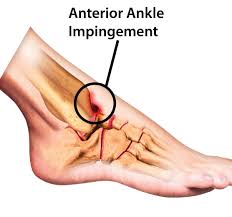Clinical prediction rule for Anterolateral Ankle Impingement
Patients complain of constant ankle pain…
Patients complain of constant anterior and/or lateral ankle pain upon activities or ambulation without a current history of trauma but mostly with past history of inversion ankle sprains, especially after anterior talofibular ligament injury. They may also present with the history of forced plantar flexion and supination injuries resulting anterolateral capsular tissue damage.
What causes impingement?
Impingement is caused mainly due to inadequate and/or improper healing of previous ankle injuries.It may be due to thickening of a joint capsule, scar formation, reactive synovitis or development of bone spurs adjacent to anterior talocrural or ankle joint.
Liu et al. (1997) developed a clinical prediction rule for ankle impingement which can be used to exclude the need of MRI to diagnose anterolateral ankle impingement and start conservative management.
Clinical prediction rule for Anterolateral Ankle Impingement  (Five of six symptoms must be positive) Anterolateral ankle joint tenderness Anterolateral ankle joint swelling Pain on forced dorsiflexion Single leg squat on affected side will be painful. Pain with activities Absence of ankle instability[Reference: From Liu SH, Nuccion SL, Finerman G. Diagnosis of anterolateral ankle impingement: comparison between magnetic resonance imaging and clinical examination. Am J Sports Med 25:389-393, 1997.] |
Physiotherapist can help
A physiotherapist mostly focuses on restoring or improving joint space for free movement of the joint and hence to improve pain-free activities.
Acute phase
Physiotherapy treatment starts with a period of rest and gentle ankle mobilization exercises in order to reduce acute pain and symptoms. Also, to improve or maintain available range of motion of the joint.
Chronic Phase:
- manual therapy techniques such as joint distraction, anterior/posterior or lateral talocrural glides, and distal fibula glides.
- Similarly, cuboid whip and other joint mobilization techniques to improve joint range of motion.
- With the improvement of joint flexibility and reduced pain, a progressive ankle resistance exercise is recommended.
- Followed by ankle stability and balance exercise protocols so that patient can return to his normal or sporting activities safely.



My partner and I went here from a different website and thought I should check things out. I like what I see so now i’m following you. Look forward to looking at your web page repeatedly.
A person essentially assist to make severely articles I would state. This is the very first time I frequented your website page and up to now? I amazed with the research you made to create this actual post amazing. Magnificent job!